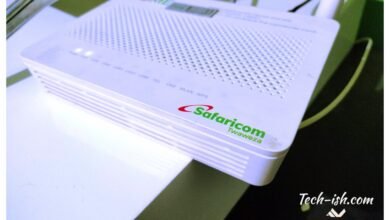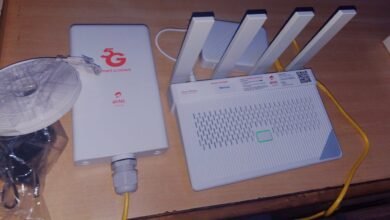
We all know 5G will bring lightning-fast mobile broadband. But the phone is the least exciting piece of the story. 5G will provide the connectivity for the fourth industrial revolution which will completely alter the way we live, work and play. 5G will also make it a sustainable revolution.
But this can’t happen, and won’t be fair if everyone is not on board. That’s something Nokia hopes to address in the coming months.
For a while now, 5G has been a preserve of expensive handsets. Nokia will be looking to change that in 2021 with new affordable 5G ready devices. This will enable the general population to experience what 5G is like, and be part of the technology that’s changing the future.
Fourth industrial revolution and mobile connectivity
Characterized by computing and the internet, the third industrial revolution profoundly impacted services businesses such as banking and the media. But industries with a lot of heavy equipment, production lines and materials-handling missed out on this ‘digital revolution’.
But that is set to change with the fourth industrial revolution, or Industry 4.0, which will use digitalization and automation to sustainably source resources, move them to market, manufacture, power, operate and service all aspects of our new, technological world, including the management of our cities and the well-being of people and the planet.
Industry 4.0 is being powered by mobile networks starting with carrier-grade 4G in the form of private wireless networks and migrating to 5G as business needs emerge. The cabled and Wi-Fi networks that work well in an office setting aren’t designed for mobility making them unsuitable in an industrial setting. Cable will continue to have its place but is challenged when it comes to scaling and connecting multiple assets. Although they are wireless, Wi-Fi and other legacy wireless technologies lack coverage, reliability, predictable performance, security and mobility.
Mobile networks have greater capacity, large coverage, fewer blind spots, better signal penetration and are designed to reliably connect devices which need to move freely and in difficult radio environments. And most importantly, they provide predictable lower latency, which is essential for machine-to-machine connectivity such as robotics where there can be no delay variation from instruction to reaction.
The 5G advantage
- High Speed and capacity
We all know that 5G boasts higher speeds and capacity than 4G but understanding why helps explain how 5G will be more sustainable than previous generations.
Mobile technologies use radio waves to transmit data. When we make a call, send a text or stream a video, our phones convert the content into packets of digital code (1 and 0s) which are then transmitted over radio waves and decoded the other end. Think of radio waves as waves on the ocean, differing by frequency and amplitude (or height). The digital signal is encoded by making small variations to the wave pattern.
5G can be implemented in any part of spectrum. In higher frequencies, governments can assign more bandwidth, or frequency range, to the services which then makes it possible to transmit more data. For example, while in lower frequencies the channel blocks are usually around 10-20 MHz, in higher frequencies the channel blocks range around 100-200 MHz.
5G equipment comes in all shapes and sizes, giving operators more options as they design their networks. Antenna arrays known as ‘Massive MIMO’ (multiple-input multiple-output) can increase capacity without requiring more spectrum by allowing the transmitting and receiving of more than one data signal simultaneously over the same radio channel. Deployed indoors and outdoors, ‘Small Cells’ provide coverage in data traffic hotspots, complementing the cover of the macro cells.
- Spectrum bands
The 5G spectrum range of radio frequencies being allocated by national governments is much broader than previous generations.
Operators and enterprises can take advantage of the different characteristics of each spectrum. In areas of high network traffic – urban areas, stadia, airports etc – operators can use higher frequency spectrum to deliver the high bandwidth and capacity per radio antenna.
But lower frequency spectrum has its own advantage. The signal has better penetration in buildings and naturally propagates further than high frequency spectrum, making it suitable for lower density network traffic in rural locations.
- Ultra-reliable low latency
When the industry talks about 5G, it is referring to a set of mobile networks specifications produced by the mobile technologies standards body, 3GPP. When data is transmitted, it is broken down into small packets. One of 5G specifications is for ultra-reliable low latency which is crucial in use-cases such as performing remote heart surgery or for self-driving cars, when losing connection for a couple of seconds is not an option.
The 3GPP specifications are defined as requiring 99.9999% of packets to be delivered within one millisecond. This ‘6x9s’ reliability is achieved through lots of technological advances in network design such as baking in near-instantaneous packet failover, software defined (as opposed to hardwire) network routing, and more redundancy.
Latency is the delay in a network between an instruction being given and the action being commenced. Low latency enables robots or vehicles to be remote controlled, or even to work autonomously. Imagine an operator remotely controlling a vehicle at a port which is carrying a container. The operator would need to have the same or better control as if he or she were physically driving the vehicle with no delay to the steering or breaking mechanisms.
- More sustainable
The 5G network can transmit 100 times more data per unit of energy. This is delivered by using higher frequency spectrum for more efficient data transmission, and by enhancements in equipment design, i.e. Massive MIMO is more energy efficient than previous antenna configurations.
Research undertaken by Nokia and Telefónica found 5G networks are up to 90 percent more energy efficient per traffic unit than legacy networks
Moreover, there is an enabling effect. GSMA, the mobile operator industry body, and the Carbon Trust found that through digitalization and automation, 5G has the potential to decrease emissions in other sectors by 10 times the amount of emissions produced by mobile networks themselves.
5G enables new network capabilities
As well as being faster, with higher capacity, more reliability and lower latency, 5G is a complete re-imagination of the network. As such, it includes new features that expand the service capabilities of the network.
- Network slicing
In previous generations – 2G, 3G and 4G – the traditional end-to-end network provided the same service to all users. If an operator’s customer, such as the police or fire brigade, required a guaranteed level of service for an application, the only option would have been to create a new, physical network or to deploy a Virtual Private Network. 5G is changing that with the introduction of network slicing.
With network slicing, operators can create virtual, independent networks within the same physical network. Whether it’s connecting a handset to mobile broadband or a robot to an automation application, the network operator can guarantee speed, latency, reliability and security service levels for the slice as if it was a distinct network.
A network slice is equipment-vendor agnostic and can span across a radio network provided by vendor one, to the core from vendor two and so on. This means it can be used in scenarios covering wide geographies.
A sports stadium might have slices for fans to upload selfies, another for security monitoring and another for the broadcast provider. Each would have different requirements and priorities, and functions to enable each slice would be distributed differently. The traffic in the security and broadcast slices will always get the guaranteed bandwidth even if 50,000 fans celebrate a goal by trying to share their recorded video.
- Edge computing
If you are being driven by an autonomous car and another vehicle loses control and heads your way, you don’t want your car to send data down to a remote cloud server before it takes evasive action. You want the computation work to be carried as close as possible to where you are, so the latency associated to this task is kept to a minimum. This is edge computing, which offers cloud-computing capabilities at the ‘edge’ of the network.
Edge computing capabilities, when combined with 5G networks, also enable interactive and delay-sensitive applications such as gaming and augmented reality. In an industrial setting where edge computing is already commonly used in 4G private wireless networks, warehouse and factory operators can reduce costs by moving the bulk of the computing power of the robots to the network core, meaning robots can be lighter, more agile, use less energy and are less expensive.
- Internet of Things
Connected by mobile networks, Internet of Things (IoT) sensors and devices are everywhere. The Covid-19 vaccine is accompanied by sensors which continually monitor temperature to ensure the integrity of the cold chain. IoT devices are being deployed to monitor crops, soil acidity, temperature and irrigation and help farmers take the right decisions. And healthcare, manufacturing and smart cities make use of them in their millions.
- Open RAN
Open RAN (Radio Access Network) is a hot topic for the telecoms industry. As networks have become more sophisticated, they have also become more equipment vendor homogenous. This is particularly so for the RAN, the visible piece of the network which includes the antennas we see on towers and the base stations.
With Open RAN, the protocols and interfaces between the various RAN building blocks (radio antenna, hardware and software) are ‘opened’ so mobile network operators can use equipment from multiple vendors and still ensure interoperability.
With more vendors providing the building blocks, there is more innovation and more options for the Operators. Another feature of Open RAN is the RAN Intelligent Controller (RIC) which adds programmability. For example, artificial intelligence can be introduced via the RIC to optimize the network in the vicinity of a football stadium on a match day.
- Private wireless
Private wireless is a standalone network focused on industrial operational assets and users. A private wireless network provides wireless broadband connectivity, like a public wireless network but is owned and controlled by the organization that built or purchased it. Industry verticals and public sector domains such as mining, utilities, factories, warehouses, ports, airports, public safety and smart cities all make excellent candidates for private wireless and are already using such networks to help digitalize their operations.
Private companies and enterprises are turning to private wireless for its advantages over cabled or WiFi networks. Most of these are available today and will be further strengthened with 5G.
- Intrinsic security with built-in encryption and authentication capabilities
- Mission-critical reliability to keep systems up and running
- Ubiquitous connectivity across large campuses sites, indoors and outdoors
- Meet growing demands and a single wireless network for operational technology needs with predictable high data rates and low latency, but also support critical voice and low power sensors.
- High multi-user capacity
- Supports advanced applications on mobile assets and transparent handovers to public networks
- Reduced interferences from production processes in heavy industrial environments, such as welding







